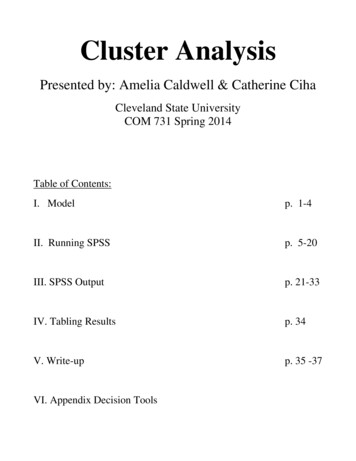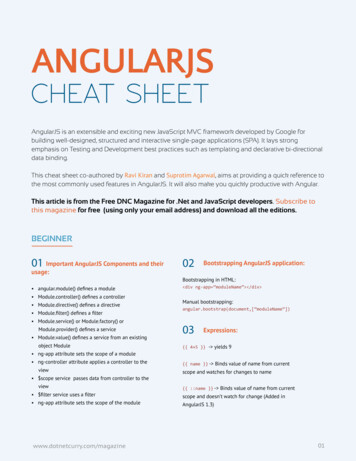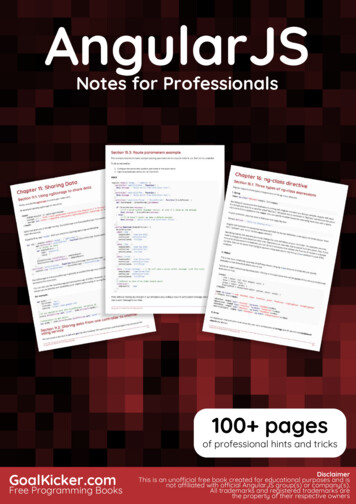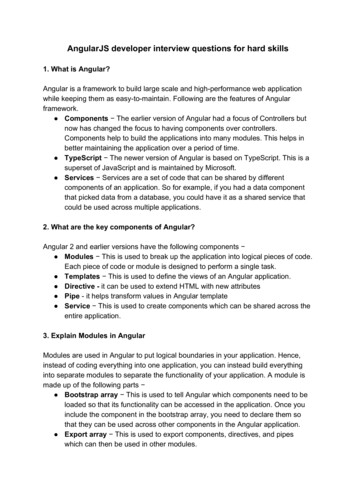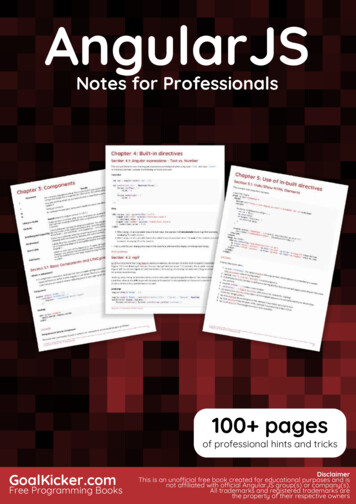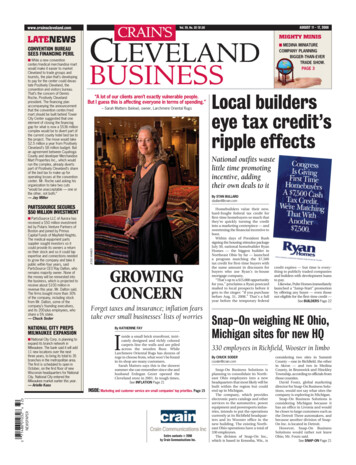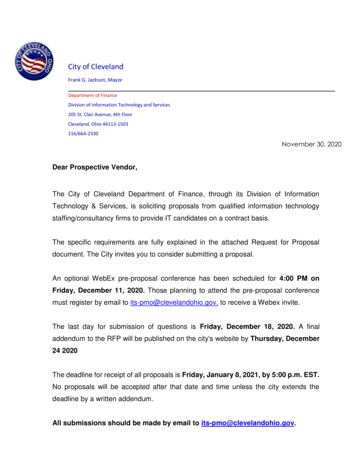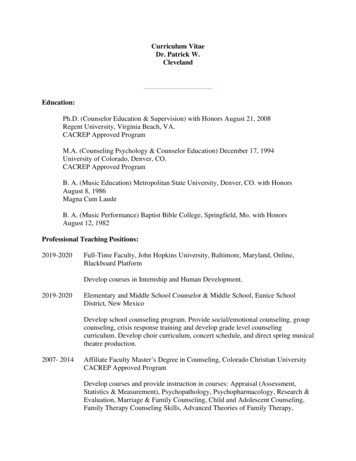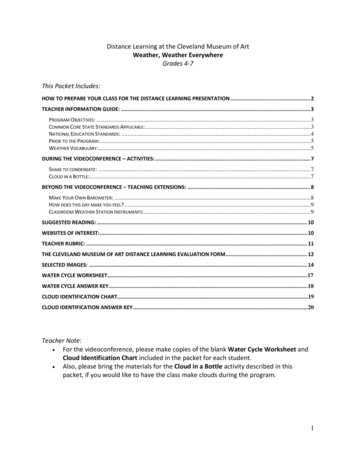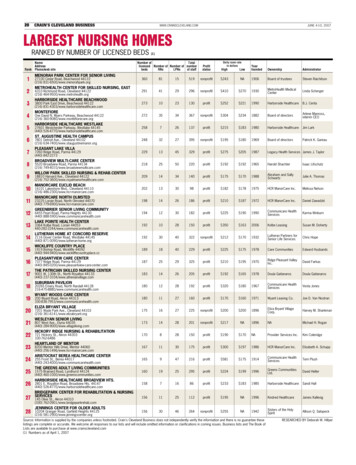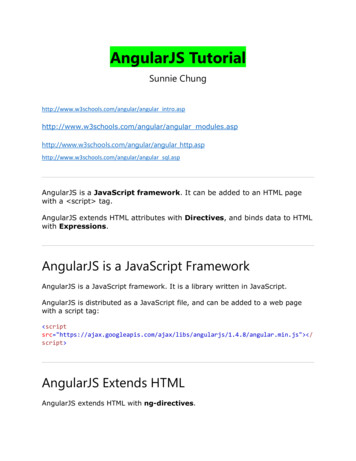
Transcription
AngularJS TutorialSunnie Chunghttp://www.w3schools.com/angular/angular intro.asphttp://www.w3schools.com/angular/angular r http.asphttp://www.w3schools.com/angular/angular sql.aspAngularJS is a JavaScript framework. It can be added to an HTML pagewith a script tag.AngularJS extends HTML attributes with Directives, and binds data to HTMLwith Expressions.AngularJS is a JavaScript FrameworkAngularJS is a JavaScript framework. It is a library written in JavaScript.AngularJS is distributed as a JavaScript file, and can be added to a web pagewith a script tag: scriptsrc .4.8/angular.min.js" /script AngularJS Extends HTMLAngularJS extends HTML with ng-directives.
The ng-app directive defines an AngularJS application.The ng-model directive binds the value of HTML controls (input, select,textarea) to application data.The ng-bind directive binds application data to the HTML view. AngularJSExample !DOCTYPE html html scriptsrc .4.8/angular.min.js" /script body div ng-app "" p Name: input type "text" ng-model "name" /p p ng-bind "name" /p /div /body /html Example explained:AngularJS starts automatically when the web page has loaded.The ng-app directive tells AngularJS that the div element is the "owner" ofan AngularJS application.The ng-model directive binds the value of the input field to the applicationvariable name.The ng-bind directive binds the innerHTML of the p element to theapplication variable name.AngularJS DirectivesAs you have already seen, AngularJS directives are HTML attributes with an ngprefix.
The ng-init directive initializes AngularJS application variables.
AngularJS ExampleAngularJS controllers control the data of AngularJS applications.AngularJS controllers are regular JavaScript Objects.AngularJS Modules❮ Previous Next ❯An AngularJS module defines an application.
The module is a container for the different parts of an application.The module is a container for the application controllers.Controllers always belong to a module.Creating a ModuleA module is created by using the AngularJS function angular.module div ng-app "myApp" . /div script var app angular.module("myApp", []); /script The "myApp" parameter refers to an HTML element in which the application willrun.Now you can add controllers, directives, filters, and more, to your AngularJSapplication.Adding a ControllerAdd a controller to your application, and refer to the controller with the ngcontroller directive:Example div ng-app "myApp" ng-controller "myCtrl" {{ firstName " " lastName }} /div script var app angular.module("myApp", []);
app.controller("myCtrl", function( scope) { scope.firstName "John"; scope.lastName "Doe";}); /script You will learn more about controllers later in this tutorial.Adding a DirectiveAngularJS has a set of built-in directives which you can use to add functionalityto your application.For a full reference, visit our AngularJS directive reference.In addition you can use the module to add your own directives to yourapplications:Example div ng-app "myApp" w3-test-directive /div script var app angular.module("myApp", []);app.directive("w3TestDirective", function() {return {template : "I was made in a directive constructor!"};}); /script You will learn more about directives later in this tutorial.Modules and Controllers in Files
It is common in AngularJS applications to put the module and the controllers inJavaScript files.In this example, "myApp.js" contains an application module definition, while"myCtrl.js" contains the controller:Example !DOCTYPE html html scriptsrc .4.8/angular.min.js" /script body div ng-app "myApp" ng-controller "myCtrl" {{ firstName " " lastName }} /div script src "myApp.js" /script script src "myCtrl.js" /script /body /html myApp.jsvar app angular.module("myApp", []);The [] parameter in the module definition can be used to define dependentmodules.Without the [] parameter, you are not creating a new module, but retrieving anexisting one.myCtrl.jsapp.controller("myCtrl", function( scope) { scope.firstName "John"; scope.lastName "Doe";});
Functions can Pollute the Global NamespaceGlobal functions should be avoided in JavaScript. They can easily be overwrittenor destroyed by other scripts.AngularJS modules reduces this problem, by keeping all functions local to themodule.When to Load the LibraryWhile it is common in HTML applications to place scripts at the end of the body element, it is recommended that you load the AngularJS library either inthe head or at the start of the body .This is because calls to angular.module can only be compiled after the libraryhas been loaded.Example !DOCTYPE html html body scriptsrc .4.8/angular.min.js" /script div ng-app "myApp" ng-controller "myCtrl" {{ firstName " " lastName }} /div script var app angular.module("myApp", []);app.controller("myCtrl", function( scope) { scope.firstName "John"; scope.lastName "Doe";}); /script /body /html
AngularJS ControllersAngularJS applications are controlled by controllers.The ng-controller directive defines the application controller.A controller is a JavaScript Object, created by a standard JavaScript objectconstructor.AngularJS Example div ng-app "myApp" ng-controller "myCtrl" First Name: input type "text" ng-model "firstName" br Last Name: input type "text" ng-model "lastName" br br Full Name: {{firstName " " lastName}} /div script var app angular.module('myApp', []);app.controller('myCtrl', function( scope) { scope.firstName "John"; scope.lastName "Doe";}); /script Application explained:The AngularJS application is defined by ng-app "myApp". The applicationruns inside the div .The ng-controller "myCtrl" attribute is an AngularJS directive. It defines acontroller.The myCtrl function is a JavaScript function.AngularJS will invoke the controller with a scope object.
In AngularJS, scope is the application object (the owner of applicationvariables and functions).The controller creates two properties (variables) in the scope (firstName andlastName).The ng-model directives bind the input fields to the controller properties(firstName and lastName).Controller MethodsThe example above demonstrated a controller object with two properties:lastName and firstName.A controller can also have methods (variables as functions):AngularJS Example div ng-app "myApp" ng-controller "personCtrl" First Name: input type "text" ng-model "firstName" br Last Name: input type "text" ng-model "lastName" br br
Full Name: {{fullName()}} /div script var app angular.module('myApp', []);app.controller('personCtrl', function( scope) { scope.firstName "John"; scope.lastName "Doe"; scope.fullName function() {return scope.firstName " " scope.lastName;};}); /script Controllers In External FilesIn larger applications, it is common to store controllers in external files.Just copy the code between the script tags into an external file namedpersonController.js:AngularJS Example div ng-app "myApp" ng-controller "personCtrl" First Name: input type "text" ng-model "firstName" br Last Name: input type "text" ng-model "lastName" br br Full Name: {{fullName()}} /div script src "personController.js" /script Another Example
For the next example we will create a new controller file:angular.module('myApp', []).controller('namesCtrl', function( scope) { scope.names ve the file as namesController.js:And then use the controller file in an application:AngularJS Example div ng-app "myApp" ng-controller "namesCtrl" ul li ng-repeat "x in names" {{ x.name ', ' x.country }} /li /ul /div script src "namesController.js" /script
AngularJS FormsForms in AngularJS provides data-binding and validation of input controls.Input ControlsInput controls are the HTML input elements: input elementsselect elementsbutton elementstextarea elementsData-BindingInput controls provides data-binding by using the ng-model directive. input type "text" ng-model "firstname" The application does now have a property named firstname.The ng-model directive binds the input controller to the rest of your application.The property firstname, can be referred to in a controller:Example script var app angular.module('myApp', []);app.controller('formCtrl', function( scope) { scope.firstname "John";}); /script
It can also be referred to elsewhere in the application:Example form First Name: input type "text" ng-model "firstname" /form h1 You entered: {{firstname}} /h1 CheckboxA checkbox has the value true or false. Apply the ng-model directive to acheckbox, and use its value in your application.ExampleShow the header if the checkbox is checked: form Check to show a header: input type "checkbox" ng-model "myVar"
/form h1 ng-show "myVar" My Header /h1 RadiobuttonsBind radio buttons to your application with the ng-model directive.Radio buttons with the same ng-model can have different values, but only theselected one will be used.ExampleDisplay some text, based on the value of the selected radio button: form Pick a topic: input type "radio" ng-model "myVar" value "dogs" Dogs input type "radio" ng-model "myVar" value "tuts" Tutorials input type "radio" ng-model "myVar" value "cars" Cars /form The value of myVar will be either dogs, tuts, or cars.SelectboxBind select boxes to your application with the ng-model directive.The property defined in the ng-model attribute will have the value of theselected option in the selectbox.ExampleDisplay some text, based on the value of the selected option:
form Select a topic: select ng-model "myVar" option value "" option value "dogs" Dogs option value "tuts" Tutorials option value "cars" Cars /select /form The value of myVar will be either dogs, tuts, or cars.An AngularJS Form ExampleFirst Name:Last Name:RESETform {"firstName":"John","lastName":"Doe"}master {"firstName":"John","lastName":"Doe"}Application Code div ng-app "myApp" ng-controller "formCtrl" form novalidate First Name: br input type "text" ng-model "user.firstName" br Last Name: br input type "text" ng-model "user.lastName" br br button ng-click "reset()" RESET /button /form p form {{user}} /p
p master {{master}} /p /div script var app angular.module('myApp', []);app.controller('formCtrl', function( scope) { scope.master {firstName: "John", lastName: "Doe"}; scope.reset function() { scope.user angular.copy( scope.master);}; scope.reset();}); /script The novalidate attribute is new in HTML5. It disables any default browservalidation.Example ExplainedThe ng-app directive defines the AngularJS application.The ng-controller directive defines the application controller.The ng-model directive binds two input elements to the user object in themodel.The formCtrl controller sets initial values to the master object, and defines thereset() method.The reset() method sets the user object equal to the master object.The ng-click directive invokes the reset() method, only if the button is clicked.The novalidate attribute is not needed for this application, but normally you willuse it in AngularJS forms, to override standard HTML5 validation.
AngularJS AJAX - httphttp://www.w3schools.com/angular/angular http.asp http is an AngularJS service for reading data from remote servers.AngularJS httpThe AngularJS http service makes a request to the server, and returns aresponse.ExampleMake a simple request to the server, and display the result in a header: div ng-app "myApp" ng-controller "myCtrl" p Today's welcome message is: /p
h1 {{myWelcome}} /h1 /div script var app angular.module('myApp', []);app.controller('myCtrl', function( scope, http) { http.get("welcome.htm").then(function(response) { scope.myWelcome response.data;});}); /script MethodsThe example above uses the .get method of the http service.The .get method is a shortcut method of the http service. There are severalshortcut methods: )The methods above are all shortcuts of calling the http service:Examplevar app angular.module('myApp', []);app.controller('myCtrl', function( scope, http) { http({method : "GET",url : "welcome.htm"}).then(function mySucces(response) {
scope.myWelcome response.data;}, function myError(response) { scope.myWelcome response.statusText;});});The example above executes the http service with an object as an argument.The object is specifying the HTTP method, the url, what to do on success, andwhat to do on failure.PropertiesThe response from the server is an object with these properties: .config the object used to generate the request.data a string, or an object, carrying the response from the server.headers a function to use to get header information.status a number defining the HTTP status.statusText a string defining the HTTP status.Examplevar app angular.module('myApp', []);app.controller('myCtrl', function( scope, http) { http.get("welcome.htm").then(function(response) { scope.content response.data; scope.statuscode response.status; scope.statustext response.statustext;});});To handle errors, add one more functions to the .then method:Examplevar app angular.module('myApp', []);app.controller('myCtrl', function( scope, http) { http.get("wrongfilename.htm")
.then(function(response) {//First function handles success scope.content response.data;}, function(response) {//Second function handles error scope.content "Something went wrong";});});JSONThe data you get from the response is expected to be in JSON format.JSON is a great way of transporting data, and it is easy to use within AngularJS,or any other JavaScript.Example: On the server we have a file that returns a JSON object containing 15customers, all wrapped in array called records.Take a look at the JSON object. customers.php{"records": [{"Name": "Alfreds Futterkiste","City": "Berlin","Country": "Germany"},{"Name": "Ana Trujillo Emparedados y helados","City": "México D.F.","Country": "Mexico"},{"Name": "Antonio Moreno Taquería","City": "México D.F.","Country": "Mexico"
},{"Name": "Around the Horn","City": "London","Country": "UK"},{"Name": "B's Beverages","City": "London","Country": "UK"},{"Name": "Berglunds snabbköp","City": "Luleå","Country": "Sweden"},{"Name": "Blauer See Delikatessen","City": "Mannheim","Country": "Germany"},{"Name": "Blondel père et fils","City": "Strasbourg","Country": "France"},{"Name": "Bólido Comidas preparadas","City": "Madrid","Country": "Spain"},{"Name": "Bon app'","City": "Marseille","Country": "France"},{"Name": "Bottom-Dollar Marketse","City": "Tsawassen","Country": "Canada"},{"Name": "Cactus Comidas para llevar","City": "Buenos Aires","Country": "Argentina"},{"Name": "Centro comercial Moctezuma","City": "México D.F.",
"Country": "Mexico"},{"Name": "Chop-suey Chinese","City": "Bern","Country": "Switzerland"},{"Name": "Comércio Mineiro","City": "São Paulo","Country": "Brazil"}]}ExampleThe ng-repeat directive is perfect for looping through an array: div ng-app "myApp" ng-controller "customersCtrl" ul li ng-repeat "x in myData" {{ x.Name ', ' x.Country }} /li /ul /div script var app angular.module('myApp', []);app.controller('customersCtrl', function( scope, http) { http.get("customers.php").then(function(response) { scope.myData response.data.records;});}); /script Application explained:The application defines the customersCtrl controller, with a scope and httpobject. http is an XMLHttpRequest object for requesting external data.
http.get() reads JSON data .On success, the controller creates a property, myData, in the scope, with JSONdata from the server.
Fetching Data From a PHP Server RunningMySQLAngularJS Example div ng-app "myApp" ng-controller "customersCtrl" table tr ng-repeat "x in names" td {{ x.Name }} /td td {{ x.Country }} /td /tr /table /div script var app angular.module('myApp', []);app.controller('customersCtrl', function( scope, http) { rs mysql.php").then(function (response) { scope.names response.data.records;});}); /script Fetching Data From an ASP.NET ServerRunning SQLAngularJS Example div ng-app "myApp" ng-controller "customersCtrl" table tr ng-repeat "x in names" td {{ x.Name }} /td td {{ x.Country }} /td /tr /table
/div script var app angular.module('myApp', []);app.controller('customersCtrl', function( scope, http) { rs sql.aspx").then(function (response) { scope.names response.data.records;});}); /script Server Code ExamplesThe following section is a listing of the server code used to fetch SQL data.1.2.3.4.UsingUsingUsingUsingPHP and MySQL. Returning JSON.PHP and MS Access. Returning JSON.ASP.NET, VB, and MS Access. Returning JSON.ASP.NET, Razor, and SQL Lite. Returning JSON.Cross-Site HTTP RequestsRequests for data from a different server (than the requesting page), are calledcross-site HTTP requests.Cross-site requests are common on the web. Many pages load CSS, images,and scripts from different servers.In modern browsers, cross-site HTTP requests from scripts are restricted tosame site for security reasons.The following line, in our PHP examples, has been added to allow in: *");header("Access-Control-Allow-Origin: *");
1. Server Code PHP and MySQL ?phpheader("Access-Control-Allow-Origin: *");header("Content-Type: application/json; charset UTF-8"); conn new mysqli("myServer", "myUser", "myPassword", "Northwind"); result conn- query("SELECT CompanyName, City, Country FROM Customers"); outp "";while( rs result- fetch array(MYSQLI ASSOC)) {if ( outp ! "") { outp . ",";} outp . '{"Name":"' . rs["CompanyName"] . '",'; outp . '"City":"'. rs["City"]. '",'; outp . '"Country":"'. rs["Country"]. '"}';} outp '{"records":['. outp.']}'; conn- close();echo( outp);? 2. Server Code PHP and MS Access ?phpheader("Access-Control-Allow-Origin: *");header("Content-Type: application/json; charset ISO-8859-1"); conn new COM("ADODB.Connection"); conn- open("PROVIDER Microsoft.Jet.OLEDB.4.0;Data Source Northwind.mdb"); rs conn- execute("SELECT CompanyName, City, Country FROM Customers"); outp "";while (! rs- EOF) {if ( outp ! "") { outp . ",";} outp . '{"Name":"' . rs["CompanyName"] . '",'; outp . '"City":"'. rs["City"]. '",'; outp . '"Country":"'. rs["Country"]. '"}'; rs- MoveNext();} outp '{"records":['. outp.']}';
conn- close();echo ( outp);? 3. Server Code ASP.NET, VB and MS Access %@ Import Namespace "System.IO"% %@ Import Namespace "System.Data"% %@ Import Namespace "System.Data.OleDb"% n", "*")Response.AppendHeader("Content-type", "application/json")Dim conn As OleDbConnectionDim objAdapter As OleDbDataAdapterDim objTable As DataTableDim objRow As DataRowDim objDataSet As New DataSet()Dim outpDim cconn New OledbConnection("Provider Microsoft.Jet.OLEDB.4.0;datasource Northwind.mdb")objAdapter New OledbDataAdapter("SELECT CompanyName, City, Country FROMCustomers", conn)objAdapter.Fill(objDataSet, "myTable")objTable objDataSet.Tables("myTable")outp ""c chr(34)for each x in objTable.Rowsif outp "" then outp outp & ","outp outp & "{" & c & "Name"& c & ":" & c & x("CompanyName") & c & ","outp outp &c & "City"& c & ":" & c & x("City")& c & ","outp outp &c & "Country" & c & ":" & c & x("Country")& c & "}"nextoutp "{" & c & "records" & c & ":[" & outp & "]}"response.write(outp)conn.close%
4. Server Code ASP.NET, Razor C# and SQL Origin", "*")Response.AppendHeader("Content-type", "application/json")var db Database.Open("Northwind");var query db.Query("SELECT CompanyName, City, Country FROM Customers");var outp ""var c chr(34)}@foreach(var row in query){if outp "" then outp outp ","outp outp "{" c "Name" c ":" c @row.CompanyName c ","outp outp c "City" c ":" c @row.City c ","outp outp c "Country" c ":" c @row.Country c "}"}outp "{" c "records" c ":[" outp "]}"@outp
AngularJS is a JavaScript framework. It can be added to an HTML page with a script tag. AngularJS extends HTML attributes with Directives, and binds data to HTML with Expressions. AngularJS is a JavaScript Framework A

